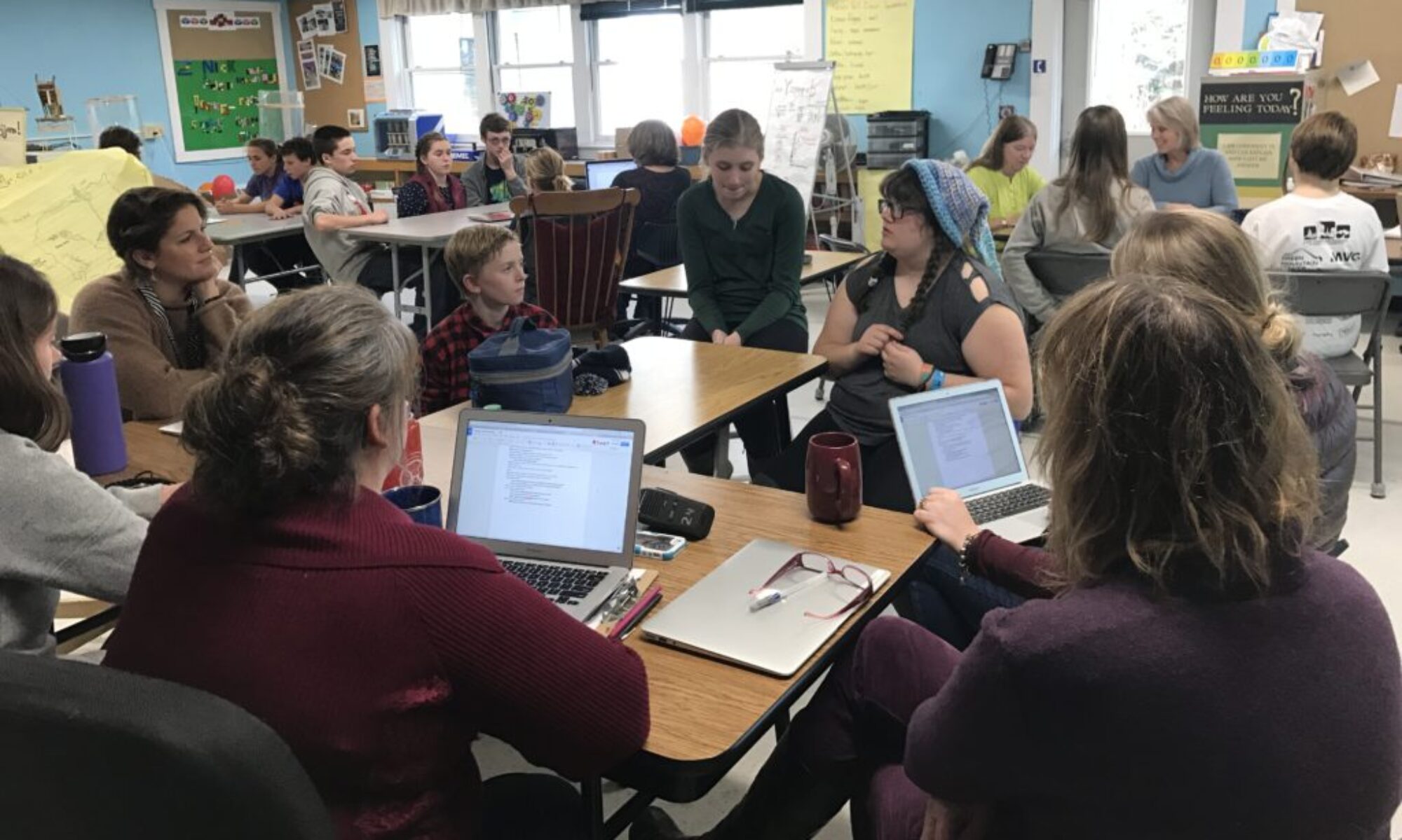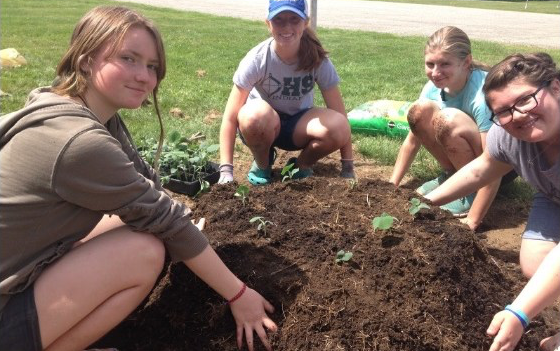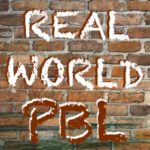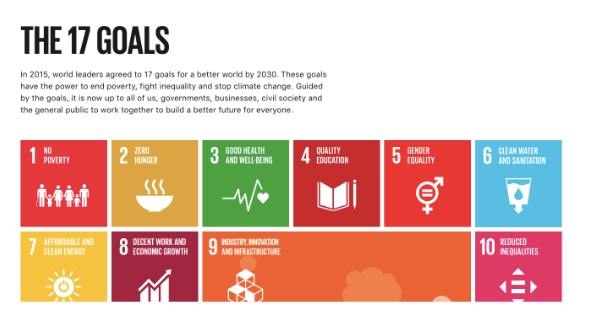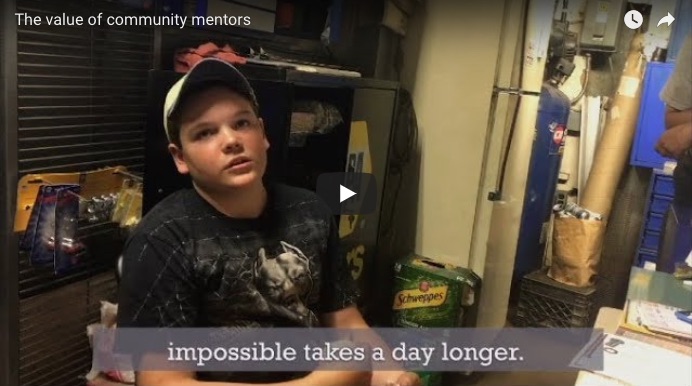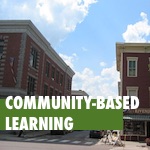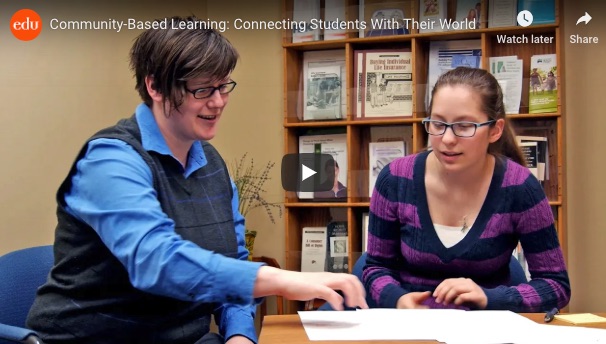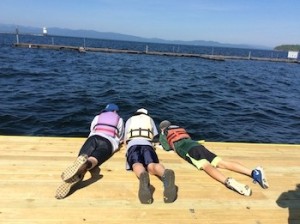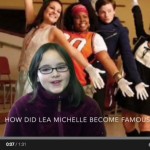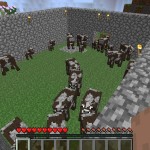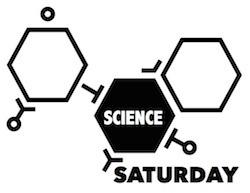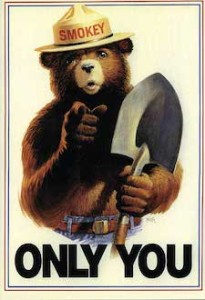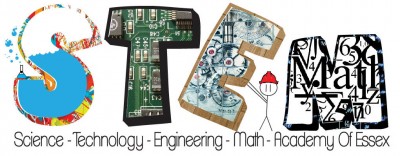Listeners, it won’t come as a shock to any of you that with the state of the world as it is many of our systems are at a breaking point, our schools in particular. But when we are all broken, that’s where the light gets in. So, as we sit here together in our brokenness, let’s make sure the break is wide enough that we can rebuild with intention, with equity, and with heart. And for that, we’re going to need a blueprint.
In this episode, we welcome author, educator, and Vermont transplant Kathleen Kesson who talks about Community Schools Blueprint: Transforming Our School Community Partnership. Kathleen and I talk about the possibilities we see for widening the cracks in traditional schooling by building opportunities for students and communities to support one another in authentic, real-world ways.
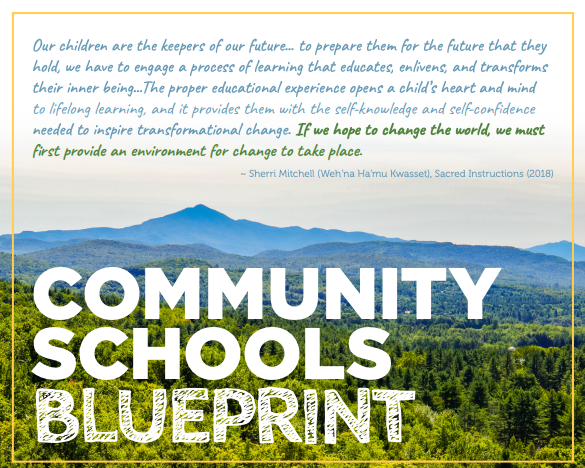
There’s lots to celebrate about the foundations of our education system, but let’s face it. Even before the pandemic, it was already deeply, deeply flawed. What can we learn from the concrete examples of innovation, a deep human connection we’ve seen emerge during this pandemic? Who are the people and your can be most wished can pass on their skills and knowledge? And what opportunities do students in your community currently have to learn those skills and knowledge? Plus, it’s very likely beyond the time we turned our elections over to middle school students. Don’t believe me? Kathleen shares how she has seen it in action.
I’m Jeanie and this is #vted Reads, a podcast about books by, for, and with Vermont educators. Let’s chat. Thank you for joining me, Kathleen. Tell us a little bit about who you are and what you do.
Kathleen: Hi, Jeanie. Thanks for inviting me to your podcast. Well, I guess we can start with what I’m doing in Vermont. I came to Vermont in 1992 as a Director of Teacher Education at Goddard College. I spent 10 years there teaching at Goddard. And for about five or six of those years, I had a funded research institute at the University of Vermont. It was called the John Dewey Project on Progressive Education. So, kind of a scholar of Dewey’s work, I was fascinated with Vermont, because this is where Dewey was born, and this is where he went to college.
And when I got the job offer up here, I was also intrigued because I knew that Vermont was one of the few places that had no standardized testing mandates at the time and no standardized textbook adoption procedures. So, I knew that teachers had a lot of autonomy, or at least I assumed that. I was really interested to see how Vermont was putting Dewey’s ideas into practice. So, I spent 10 years at Goddard. I did then get recruited by an urban university in New York City to help develop a program for teachers there and spent 17 years doing that. And I’m now happily retired, back to Vermont where I live in South Barre. And I do a lot of gardening and a lot of action and advocacy work with various organizations in the state who are continuing to work on implementing a more progressive education, policy, and practice. So that’s the professional stuff.
I’m a mother of four sons. Three of whom graduated from Montpelier High School. I’m a grandmother of three granddaughters. And just really care a lot about the future of our world and what children are learning and how schools can become more humane and more just. So, I spend most of my time writing, talking, and working toward those ends.
Jeanie: Kathleen, thank you for that introduction and also for inviting me into your home. I just want to say, this is the first in-person conversation I’ve had for the podcast since we went on lockdown at the beginning of COVID. And listeners, we are both vaxxed and boosted and we’re also at a good safe distance across the table from each other. But it’s just really lovely to be able to look at your face while we’re having this conversation.
Kathleen: Okay.
Jeanie: I love books and reading. So, I always ask my guests what they’re reading right now or if they have any reading suggestions for us.
Kathleen: Well, aside from my guilty pleasures, which often involve British detective novels that put me to sleep at night, I just received my copy of David Graeber’s, The Dawn of Everything, which is a voluminous work on the history of the world that has been reviewed recently in the Atlantic and the New York Times and The New Yorker. I’m interested in David’s work because he’s a real advocate of social ecology. I’m on the board of the Institute for Social Ecology here. And he’s really taking a new look at the history of the world, basically, and dismantling a lot of our assumptions about human progress and human development and human hierarchies and all that. So, I’m looking to that. I’m reading The Hidden Life of Trees because I’m fascinated with all the new learning and scholarship around plants and what we don’t know about plants and animals and sort of the new relationships that are developing among human intelligence and the rest of the world.
Jeanie: Mycelium?
Kathleen: Mycelium.
Jeanie: Yes, I’m interested in that too.
Kathleen: And my friend Wendy Williams, who does some work here with the VPN, she lives out in Oakland just gave me a copy of The Color of Law by Richard Rothstein. So, I’m interested in that. It sort of follows Michelle Alexander’s wonderful book on The New Jim Crow. So quite a variety. I read a lot of partial books for my writing, I find that I pick up things and reread them. I’ve got stacks laying everywhere.
Jeanie: I know you’ve got your library books there in the kitchen, too. I noticed those.
Kathleen: Right.
Jeanie: Thank you for those suggestions. Some were on my radar. But the first one you mentioned wasn’t, so I’m going to be looking for that. Let’s dig into this Community Blueprint, which, listeners, we’ll make available. It’s an online publication that we’ll make available on the Tarrant Institute blog, which you can find at vtedreads.tarrantinstitute.org, and we’ll put it in the transcript.
So, in your introduction, you write that Vermont educators don’t want to return to a pre-COVID normal. And I feel that. I hear that from educators and from students and families all over Vermont. You say that now is the time to acknowledge that that normal wasn’t working for all students. I wonder if you could just briefly in a nutshell describe a vision for the future that would move beyond that normal.
Kathleen: You said briefly, that’s a challenge.
Jeanie: Or not so briefly.
Kathleen: And I’m afraid, I probably wouldn’t phrase it that way, because I hate to make giant generalizations. And it really is true that there are a lot of people who would love to return to normal right now. I’m sure because COVID has been so grim. And people are just so overwhelmed with trying to cope with that. Normal might look pretty good right now. But there’s also a number of educators, parents, young people for whom school was not working well, either for – well, for a number of reasons. For reasons of equity or access, but also, I think there’s a sense among many people that the sort of industrial model of schooling that we really still have right now is no longer well suited to preparing young people for the future that we’re facing.
I mean, COVID may be the tip of the iceberg. We’ve got major, major challenges facing humanity right now in terms of climate change, in terms of extinctions, in terms of the failure of democracy in many places. And I think that we could all do a better job of educating young people in ways that will help them survive and thrive in the future.
So, in terms of a vision for the future, well, I would advocate for schools to become much more humane places. We have to examine all the things we do, like tracking and ranking and grading, the things that cause so much stress among even high achieving kids. I think that schools could be joyful places. They could be places that every child wanted to go to every day, because there was so much happening and so many relationships and friendships and positive experiences that we would not have a school dropout rate, we would not have kids with stomach aches who don’t want to go to school. So that’s my vision is to really make schools places where kids want to be and where parents want to send them.
And I don’t mean to say that schools are terrible. There are some wonderful, wonderful schools and I’ve visited many of them in Vermont. But I’ve also worked in Brooklyn, and I’ve seen schools there that are not joyful places, that are not humane places, where the curriculum is absolutely irrelevant to children’s lives, and they don’t necessarily want to be there. So, I’ve kind of seen the whole range of schooling practices.
Jeanie: One of the things I’m hearing from you is that even if a school might be joyful, have pockets of joy in it, pockets of humaneness, it still might have pockets of the opposite.
Kathleen: Exactly.
Jeanie: And then there’s this other piece that it might be joyful for many, or even most students and still alienate some students.
Kathleen: That’s certainly true. I mean, we’ve all been to school. So, we all remember things like the cliques and the social classes, and the hierarchies and the power relations. I think we’ve all experienced that. And schools have not changed that much. There are still young people who feel marginalized, whether it’s around issues of race or income or sexual orientation or gender. There are kids who don’t feel welcome in school so that idea of belonging, how can we create environments where everybody feels a sense of belonging?
Jeanie: Yes, you’re just echoing so much of what some listeners and myself heard at the recent Rowland Conference where Carla Shalaby gave a beautiful keynote. And the thing that’s echoing for me and what you’re saying is that even if you’re a student who feels a sense of belonging, you’re learning lessons about community and about life when others are excluded. What you’re learning is that inclusion is conditional and that you might in the future be excluded.
Kathleen: Right.
Jeanie: And you might also be learning how to exclude others from the way that school deals with what Carla Shalaby calls the “troublemakers.”
Kathleen: Yes, that’s certainly true. And I see this in my own family. I have a granddaughter who’s a really high-achieving student. I mean, A+, honor roll, AP classes. She’s a junior in high school. And she is suffering from so much anxiety and stress and depression around trying to maintain her high achievement that it – she just says, “I was so happy during summer. And then the day school started, I started feeling like this again.” So, it’s not just kids who are academically underachieving or behind in some way, it’s also the kids who are doing really well academically.
Jeanie: The kids for whom it looks like school is working.
Kathleen: Right.
Jeanie: Yeah, I appreciate that. So, as you moved through this document, you really spend some time, I feel providing some touchstones for us along the way around some terms like localization and community. I wonder if you could spend a few minutes talking about what localization is and how you define community, and then also how you draw on that as you move towards this model of a community school.
Kathleen: I shall do that. I’ve studied school reform throughout my career looking at 50 years of school reform, even 100 years of school reform. And there’s been 1,000s of things tried, some progressive, some conservative. It’s an endless tinkering with the school system.
But the one thing that has emerged for me and partly, this is the work of my good friend, Jean Anyon, who’s no longer with us, her wonderful research on school and social class. The understanding that school doesn’t exist in a vacuum, it exists within a social, political and economic context and issues of wealth inequality and poverty and increasingly environmental degradation, things like that are sort of central issues in which schooling dwells.
And unless we were to solve the problems of poverty, and these include everything from homelessness to food insecurity, to domestic violence, I mean, the whole host of social problems that are related to poverty. School reforms are going to continue to be pretty ineffective and we’re going to have business as usual, or we will have normal until we can address the larger social issues.
This is a daunting idea. How do you change the system that we live in? Well, I think we’re getting some pretty strong indicators now that the larger system, which I’ll define as sort of a few hundred years of a fossil fuel-based economy with continuous growth at its core and consumerism as one of the higher values is kind of coming to a screeching halt perhaps. We’re realizing that material resources are finite, especially fossil fuel. We’ve got new technologies on the horizon, but we’re not quite there yet. And we need to really rethink some of the fundamentals about how we live. I think we need to rethink what we eat, what we consume, how we spend, how we organize our democracies. A lot of those things need to be I think carefully thought through to determine if they are actually serving our needs for this future that we’re facing and that we’re really in right now.
I promote the idea of localization. And I rely a lot on Helena Norberg-Hodge’s work on local futures, partly because this is what I see happening in Vermont. This is the direction Vermont is moving. I think many people here have realized the importance of food sovereignty, of supporting local agriculture, of cooperative businesses that attempt to sort of level the hierarchies of who has power, who has control. We have 160 consumer and producer cooperatives in Vermont, all those sorts of localization processes that help us toward rebuilding and revitalizing local communities.
I mean, we talk a lot about people moving away from Vermont and not having enough of a tax base, and needing more business. But I think we need to really define what kind of business do we want? What kind of economy do we want? How can we build on the tradition of town meetings and have a more participatory democracy where citizens actually have some control over their lives and over what happens in their communities? So that’s the focus on localization.
And the reason that I emphasize it in the Community Schools Blueprint is that I think we also need to rethink the relationship between schools and the community, a lot of which has already happened in Vermont. There are some wonderful community partnerships happening here. I think we need to build on this impetus toward both getting young people more involved in their communities and getting community people more involved in the schools. So that was the sort of emphasis on localization was to really do some thinking about what we value, how do we want to live and how can our schools become better expressions of those values.
Jeanie: There’s a lot there. I really appreciate the way that you laid all that out. When I read Jean Anyon, I don’t remember which article last year, I remember a big takeaway being that schools are expected to fix everything that’s wrong with our society without society having to fix anything on the outside of schools.
Kathleen: Right.
Jeanie: And so, this notion that we sometimes have as school being a great equalizer that can enable poor working-class kids to get the education to become middle class, and yet, this is our American dream of school, and yet we know that the reality, the way it plays out statistically is that school reproduces social class.
Kathleen: Absolutely. I think that’s kind of a consensus perspective of most educational scholars.
Jeanie: Yes. And so, what I hear you saying is, instead of expecting school to fix all that ails us, that community and school need to work together in order to co-create community and school in ways that are more just sustainable, equitable.
Kathleen: Yeah. That’s very well put. And I think there’s a caveat here. Localization has, in our history, sometimes been provincialism. We’re not thinking that we’ve got to pull back and reject the sort of larger connections. What’s happening right now is sort of a – some people call it translocalism. We are getting both globally interconnected, really connecting with many people in other countries who are sharing these kinds of values, and at the same time developing more of a local focus.
I mean, let’s face it. Localization was one reason why many people, mostly in the south, but other places too, rejected the school integration in the 1950s. They said, well, we don’t want to do this and so we’re going to start private schools, whites only academies. And that’s when the private school, often Christian schools, which often were independent schools, proliferated because local people rejected the federal imposition. So, we’re in a very new place right now, because I think that we’re having really vital conversations about equity, about racism, about decolonization, about what we need to do to sort of right the wrongs, address the wrongs, repair the wrongs of the past. Part of localization is having those conversations.
Jeanie: How do community schools address issues of equity? Specifically, how might they disrupt inequities?
Kathleen: Good question. When I started researching community schools, I realized, first of all, it’s not a new thing. It’s been going on for a couple of decades. And I know that in many cases, community schools were initiatives by sometimes tribal indigenous communities and sometimes city communities where parents really wanted more influence over the schools and the curriculum. So, it’s been around for a while. It’s picked up a lot of steam since about 2000. And my sense is that the community school movement emerged because of kind of a neoliberal consensus that poverty was at the root of the so-called achievement gap.
So, I think community schools are sort of at their core, an effort to remediate some of the core issues that relate to the income gap. And my understanding is that if you look at the pillars of community schools, the idea of integrated student supports, what kind of supports do students need to sort of help them achieve at higher levels? They talk about expanded and enriched learning time; so, after school programs, summer programs, things like that. They focus on active family and community engagement. Although, they do talk about partnerships, and they talk about collaborative leadership and practices.
So many community schools try to do things like develop partnerships with social service agencies so that they can get a dentist for kids who don’t have dental care, more social workers, more counselors, things like that. They generally are not talking about really looking at the social system as a whole and thinking about ways to really disrupt inequity in terms of discussions like decolonizing education or anti-racist education. It’s kind of a benevolent liberal approach, I would think to remediating the achievement gap.
I do know that Vermonters who’ve been interested in community schools worked a lot when our legislation was being passed. We have some recent legislation that is providing funding to at least five districts to initiate pilots in community schools. And I know that some of the people involved in testimony really were pushing for an increased attention to equity in the community schools. So, I think Vermont is the only state who has really developed a sense of a real focus on equity as part of the community schools movement. So, we can see what kind of effect that has. But the Blueprint really, again, is pointing out the limitations of community schools. I think they’re a good example of some temporary fixes, some band aids that will be very helpful and may even help with the achievement gap. But I don’t think it addresses the long-term larger systemic issues that we need to be talking about.
Jeanie: Yeah. You early on in that said, so called achievement gap and there are other terms people use for that. One is opportunity gap, meaning that the way that schools are funded, it means some people have more opportunities than others.
Kathleen: Right.
Jeanie: There’s another one called – is it called – there’s something – somebody else uses a term like education deficit, the places where we haven’t really fully invested in education for some kids, like, we have for other kids.
Kathleen: Yeah. And I think these discussions about people weighting factors and equalizing funding, they’re all extremely important. A lot of the discussions around achievement, opportunity and access don’t question the way the curriculum and the learning are structured, or even the content. It’s really more about how can more people do better with what we have. I’m suggesting otherwise that we need a radical in the sense of getting to the root of the problem, rethinking of the curriculum itself.
Jeanie: I really appreciate that. I just got a chance to see Gholdy Muhammad give a keynote. She’s written a book called Cultivating Genius that I’ve talked about on the podcast in the past. And one of the things she said that just really stuck with me is that is a caution about how we talk about students. And the example she gave was that we sometimes talk about students who struggle. And she says, I will not start there, I will not start with a deficit approach.
Kathleen: Right.
Jeanie: And I’m not going to assume that kids are struggling. I’m going to ask myself, where is my pedagogy struggling? Where’s my curriculum struggling? Where’s the culture of my classroom struggling?
Kathleen: Right.
Jeanie: And looking at those things, as opposed to struggling kids, because if we think about it as kids then we think our curriculum and our pedagogy is just fine. It’s a kid’s problem. But if we say, hey, this curriculum, this pedagogy isn’t working for all students then that has to change, not the kids.
Kathleen: Right. And it could be pedagogy, it could be methods of instruction, it could be the content of the curriculum itself or it could be the structure of schooling. A child, for example, who’s absolutely uninterested in the topic that the teacher is very interested in may have an attention deficit. But this may not be a deficit, it just may be that the child is not interested. So why are we teaching subjects instead of working with children to find out what they’re interested in, what they’re curious about, and designing entire curriculums around the questions that kids have about the world they live in. I have met remarkable teachers who do this very successfully. So, it’s not a pie in the sky idea.
Jeanie: I will say my – I was a Rowland Fellow in 2014. And that’s what my Rowland fellowship was built around, students interest building, especially in school library and research opportunities for kids to really dig in research and move into actually doing something, about something they were interested in. One of the surprising findings for me is that interest is itself a skill and that you know people who are really interested in lots of things, they can be interested in just about anything.
Kathleen: Right.
Jeanie: And then I also know people in my own life who are interested in nothing. And that’s also – like, it’s like we almost wear it out of kids. And so, if you just say to kids, what are you interested in, you might get a lot of blank stares. It’s something you have to cultivate over time.
Kathleen: Absolutely.
Jeanie: And we can help create kids who are more interested in their communities, in the worlds around them in the way that we teach.
Kathleen: Yeah.
Jeanie: By teaching them to ask questions, by helping them think about how some thing is relevant to their lives and the lives of people they love by taking them out. I know in your Community Schools Blueprint, you talk about place-based learning and service learning, getting them out in their communities to see their real-world implications.
Kathleen: Right. Well, I think, thinking about the structure of schooling, I have never met a two-year-old who wasn’t interested in the world.
Jeanie: Yes.
Kathleen: Perhaps if a child had severe neurological damage or something like that, they might not exhibit a lot of interest. But those two-year olds want to take it in and learn everything they can learn about how far can I throw this food, how fast will the milk spill. Toddlers are interested in everything. 100 years ago, I taught three and four-year olds, I loved it, because they were mostly just fascinated with almost everything.
Jeanie: Listeners, it was not 100 years ago.
Kathleen: But if you look at the research on interest in school, it peaks in the second grade and then starts to drop off precipitously in the third grade. Now, I think we need to be asking ourselves why.
Jeanie: Why, yes. Well, and that’s what I mean. I was working with high school kids and upper middle school kids and they’re like, wait, you’re asking me what I’m interested in?
Kathleen: Right.
Jeanie: And some of them were really good at listing a lot of things. And for some of them, that was really hard.
Kathleen: Right.
Jeanie: And I think schools dampen their enthusiasm and interest.
Kathleen: They actually do. And in fact, I don’t know how many of your listeners might remember John Taylor Gatto. Gatto was the Teacher of the Year for a couple of years in New York City back in the 80s, I think it was. He was Teacher of the Year because his kids were so interested. He was teaching in a very income deprived community in New York City. And the kids were like getting out with cameras and taking pictures of toxic sites and exploring their community and interviewing people. And they were absolutely the most interested engaged kids in the world. So, he won this Teacher of the Year award. And then he gave a speech at Carnegie Hall and just lambasted the entire educational system for what they were not doing. And he wrote a lovely little book called Dumbing Us Down, where he sort of laid out in very simple, accessible language his critique of schooling. And he talked about, well, what we education scholars call the hidden curriculum. It’s like we think we have one curriculum. But what is it the kids are really learning?
Jeanie: Compliance.
Kathleen: And what he talks about- they’re learning that what they care about doesn’t matter.
Jeanie: Yeah.
Kathleen: They’re learning about they have to structure whatever they’re engaged in, in 45-minute intervals. They have to learn that what the teacher expects and what the authorities expect them to do is much more important than what they want to do. So, he goes on like that through the whole book. And that’s really the hidden curriculum of many schools is we’re teaching kids not to care about things.
Jeanie: Yes, exactly. Thank you for that. So, if we envision a community school, just give us like a little snapshot of what a positive community school might look like? You walk in the door, what do you see Kathleen?
Kathleen: Uh-huh. Well, I was fortunate to do quite a bit of research in 2014 when Act 77 first came out. I was looking at personalized learning programs in various schools. And one thing to know about Vermont communities are they are a wealth of resources about things that are very important to a vision of a sustainable, localized future. Vermont communities are full of solar engineers and carpenters and artists and musicians, people doing really, really interesting stuff that kids are very interested in.
So, one place I spent a lot of time was with the Renaissance Program at Twinfield School that had a very early personalized learning program. Debra Stoleroff, the person who’s run that program for the last 20 years or more would help kids think about what it is I really want to learn, what do I really want to do. She’d set them up, whether it was at the planetarium, or with a retired engineer, or with a retired anthropologist in the community, or with a blacksmith to learn to do medieval knife making. And these kids would go off. There was freedom of movement in and out of school. It wasn’t a free for all. Teachers were very connected with what the kids were doing. There was kind of accountability. The kids were reporting on what they were doing and creating portfolios.
And I know John Clark well, who was really responsible for early personalized learning out there at Mount Abe. I didn’t visit the school that much, but I understand it was also similar. So, it’s kind of labor intensive to really work with kids around what they would like to do it, but it is possible.
Jeanie: It seems to me that early on in Act 77, this conversation about personalization was a lot about individualization, what individual kids need. And what I love about this model is that it’s less about individuals and more about communities and how do we do learning together in community that is relevant to our community.
Kathleen: Right. And I know you and I have talked about this before, that’s one of my big critiques. And what I think might have been John Dewey’s critique of personalized learning would be the focus exclusively on the individual and their needs and wants. And there’s ways in which that fits right in with the current consumer capitalist society. It’s like, my playlist or whatever I want. So, I know that we’ve talked about the idea of how do you build democratic schools and democracy while encompassing individual interests. And there’s many ways to do that. I know that Andy Barker and some of his colleagues at the City and Lake Semester in Burlington, it’s a public-school option. The kids are signing up for the City and Lake Semester in a group. But it’s a democratically run group. They come up with their own questions. They are out investigating Lake Champlain, they’re investigating the City Council, they’re following their interests and they’re gathering data and they’re learning all about their local community. I think that’s kind of an exemplary program.
And that’s my vision of a program is I think most kids want to be spending time with other kids. So pure learning is just so essential. And I think there’s room for individual interests in really robust, well planned group learning situations.
Jeanie: Right. And for individual strengths, right…
Kathleen: Absolutely.
Jeanie: I’m thinking about – you’re bringing up Act 77 and legislation. It seems to me that Act 1 is also a great leverage point for this, where the work around ethnic studies allows us this opportunity to investigate our communities and who lives here and how is the community working and not working for the people who live there. And I think about some work that my friend Judy Dow does in Brattleboro where she asks kids, why are the poor houses in the floodplain, right? Like kids look into whose house is where and why. And that’s a great ethnic study’s approach to learning about your community.
Kathleen: Yeah. And conventional place-based education used to be a lot around nature study. Then learning about the wildlife and the trees and habitation, all of which is very important. But the more recent advances in scholarship around place-based education really asked us to investigate a place, who lived here? Why don’t they live here anymore? What happened to the people who lived here? What were the conflicts that took place on this land? And I think that pushes us into a deep investigation of culture in place that is very consistent with Act 1.
Jeanie: Yes.
Kathleen: Yeah.
Jeanie: So, you’ve given us a little like notion of what community schooling looks like. And you’ve talked about your own study of education reform. And I know when I was in library school, I had a professor who said, the problem with school reform is we don’t stick with anything long enough to make lasting change. We give up on it too soon, which I have to say I’ve seen that in action. My question for you Kathleen is how do we make this community school movement, especially the kind of community schools that you’re talking about, how do we get started? What are some early steps? And then how do we ensure that we keep going?
Kathleen: Well, I was reading, I think it was in the Digger about a week ago that a group of educators had made a plea to the legislature not to pass any new legislation this year. And I just think that sort of encapsulates the problem. Now, teachers can get really frustrated with new changes coming their way every single year. And some just give up and say, well, I’m not even going to get engaged, because it’s just going to change next year.
Jeanie: Yes.
Kathleen: So, I think you’re really hitting on a really important topic. Obviously, we’re not going to be stagnant. I mean, when there’s new research or new learning, you have to make some changes. But I actually think that if the people in the school, the community, the school itself, the leaders of the school, the educators and especially the youth, if they were the ones deciding what do we need to do next, it might look very different from the kind of top down initiatives that really bombard people every year. Some of them are interesting, some of them are effective, a lot of them are just sort of fly by night ideas.
I think about the new math that they introduced back in the 1950s that nobody understood. The teachers didn’t understand it. The parents didn’t understand it. It was developed by mathematicians in the best universities. And it was an absolute flop, because it just wasn’t what was suitable for the people engaged in mathematics instruction. So, I think we have to be very wary of these top-down ideas.
On the other hand, without top-down federal intervention, we might never have had school desegregation or federal lunch programs. So, I don’t know, I think maybe I’m misplacing my trust. But I think communities could actually make most of those decisions quite nicely by themselves.
Jeanie: One of the things that you and I have talked about as an entry event into growing this kind of work in schools is doing a community asset map…
Kathleen: Yeah.
Jeanie: Really creating a really thoughtful spreadsheet or database of all of the community partners and invested community members that can be a part of this process.
Kathleen: Yeah.
Jeanie: And I think in schools, it’s really easy to sort of reach out to parents and that’s it. And that assumes that other people in your community aren’t interested in the wellbeing of young people, which is, I think, a false assumption. It also assumes that other people in your community who are not parents aren’t interested in donating their time and resources or partnering and learning together with young people and educators to make a difference to the local stream or the local policies about whatever is happening in your community.
Kathleen: Right. Yeah. I’ve been promoting this since 2014, when I first learned about the legislation here was that every community needed to map their assets and every community is absolutely different. Obviously, Burlington, our urban community has lots of experiences that kids can do with businesses and various organizations. But rural communities have a wealth of assets, people who have lived there for a long time. Did you ever hear of the Foxfire movement in schools?
Jeanie: Yes.
Kathleen: I mean it was just amazing. Kids in rural Georgia were out interviewing the elders in their community about things like apple cider making and quilt making and just…
Jeanie: They’ve put out those Foxfire publications, right?
Kathleen: They put out a magazine which is still going. They earned enough money from the magazine to build a TV station. And that was in a pretty remote community. So, every community has assets. It just depends on the lens you’re looking through, whether you consider them assets or not. One time I had some boys helping me in the garden who were in an alternative program for kids who were not doing well in school, okay. These kids were a wealth of information about tracking, about wildlife, about hunting, about things that I knew nothing about, and they were able to help. They were able to help me make some decisions about my gardening that were really useful. So, it kind of depends on the lens we’re using.
But the asset mapping, we did have a project with Peoples Academy where they did some asset mapping, and the students took control of it. And it was absolutely wonderful. There’s a little article, I have a link to it in the blueprint written by a student who was very involved in the asset mapping. So, it’s a wonderful way to figure out who can do what in your community. And like you said, you’ve got to look past the familiars. There’s always the familiar business or the familiar people who did this and that and the doctor who comes into school to give a talk. But you’ve got to really cast the net wide. And especially, back to this idea of belonging, how do we make sure that everyone in the community feels welcomed, invited and that their expertise is valued in the school?
Jeanie: Well, and that’s so important that strengths-based lens to community and that we see marginalized community strengths as well. And we ask folks that don’t normally get asked, whether because of poverty or because of their racial identity what are the strengths in your community and that we really see those with a strengths-based lens.
Kathleen: Right.
Jeanie: Because so often marginalized people are further marginalized by school, because we only talk to them about deficits.
Kathleen: Right.
Jeanie: I really appreciate that. And I really appreciate this idea of an asset map. Do you know of any models that we could put on our transcript for folks to see?
Kathleen: I’m trying to think if there’s. I don’t know if there’s a model per se. But I mean you might interview for example, this young woman from Peoples Academy who wrote the article.
Jeanie: Yeah.
Kathleen: I think it’s just a kind of an investigative activity, getting kids out in the community, interviewing business owners, interviewing people who are part of different organizations. And again, I think this is a different thing about the Community Schools Blueprint. We have a conventional idea that schools need to partner with social service agencies and with government and with business. But we neglect the grassroots democratic movements that are really, actively engaged in climate justice work, in anti-racist work. And they’re more sort of on the edge of what I call the just transition. How are we going to really make a transition to a better world that’s sustaining and that’s just? So, I think that partnering with organizations like that and bringing in folks to the school to work on those issues that are really close to children’s interests is important.
Jeanie: I really appreciate that. What I found that first year of COVID, when school is disrupted in March, we were planning at the Two Rivers Supervisory Union this big Sustainable Development Goals project. And we were planning field trips that got totally disrupted.
Kathleen: Right.
Jeanie: And so, we reached out and we did Zoom field trips which are way less exciting than being in-person. But the doors that were opened because of Zoom meant that we had all sorts of people who wanted to talk to our kids. I think we offered 20 different Zoom field trips that kids could attend based on whatever they were studying. And they could attend all of them if they wanted…
Kathleen: Right.
Jeanie: With people, like one was the Black River Action Project which cleaned up streams, right, in the community where we were. Some were VINs, like more – the things that come up, like, the things that are going to rise to the top no matter what…
Kathleen: Right.
Jeanie: The obvious ones like VINs and…
Kathleen: Yeah.
Jeanie: The Champlain Maritime Museum. But some were more obscure, and it was really interesting getting kids this opportunity to meet with local community members who had interests in different areas.
Kathleen: Right.
Jeanie: And it was really memorable for kids. So that’s coming up for me is that Zoom makes that really possible in ways that it opens access in some ways.
Kathleen: Right.
Jeanie: And then the other thing that’s coming up for me as we think about that community engagement piece, it has to do with fear that sometimes we can in schools be afraid of doing things that may rock the boat, or that sort of seem to have a political agenda.
Kathleen: Right.
Jeanie: But that itself is a political agenda.
Kathleen: It is.
Jeanie: It’s just a political agenda that’s in favor of the status quo.
Kathleen: Yeah.
Jeanie: So, what do you say to folks who are like, well, we can’t do that, because what if somebody complains?
Kathleen: Well, somebody is always going to complain. I mean, we have such a polarized society right now that I think you can just expect complaints about anything. I have a piece I wrote for the English Journal that I’ll share with you. It was based on some research I did in Oklahoma, where I have a lot of ties in a Native American community, a place where there’s about 26 different tribal groups. And this community is situated on one of the worst Superfund sites in the world, worse than Love Canal, it’s called Tar Creek. And there was a guidance counselor there who was working with kids.
I’ll try to make a long story very short, who started – most of the kids had lead poisoning, so they were considered with learning disabilities. But they all started investigating their Superfund site. This was like 25, 30 years ago. They got so good at what they were doing that they published a number of books through the Cherokee Nation on what they learned about the Superfund site. They got the EPA more involved. They got Harvard University involved in epidemiological studies around lead poisoning. You would not believe the things that these kids did. And they were given a Governor’s Award at one point for their investigative expertise. I write a lot about that, because it’s an example to me of it’s not a politically neutral event to examine a Superfund site or a toxic waste dump. There are going to be people who do not want those things revealed.
Jeanie: Right.
Kathleen: But it is a moral and ethical decision. And I think we can’t underestimate the capacities of young people. That’s I think one of the biggest mistakes we make. I remember when all that stuff came out about lead, lead pipes in schools, and there was a worry about lead. But the state was throwing up their hands and going, well, we don’t have the capacity to do the testing, we can’t do this, we can’t do that. I pointed them toward the kids at Tar Creek who had been trained to investigate lead in pipes by government agencies, and who were able to go in schools, who were supplied with the testing kits, who were testing the water themselves. And I wrote to the science educators here, I put an OP Ed in the newspaper, I said, why don’t we get the kids involved in water testing in the schools. Well, guess what kind of response I got?
Jeanie: Yeah, probably not a positive way although…
Kathleen: Absolutely nothing, no.
Jeanie: What a way to raise scientists?
Kathleen: What a way to do it, right?
Jeanie: Yes.
Kathleen: You got 100 kids in Vermont investigating the lead in their water. And who knows what kind of science geniuses we might produce that way? But no, there was not the slightest bit of interest. So, I think we do really underestimate kids. I did take a trip to Cuba in the 1990s. And I did a lot of interviews with various community organizations and at the University of Havana. And I was interviewing one middle school teacher. Now, Cuba is not a haven of democracy, so don’t mistake my words here. But I said, “Well, how do you get middle school kids involved in the community??” And the person said, “Oh, that’s easy. They handle the elections.”
Jeanie: Right.
Kathleen: There are municipal elections in Nevada. And the kids run them. Here, mostly retired people run them.
Jeanie: Yeah.
Kathleen: But the kids were running the election. So, it’s like, think of all the things that young people could be doing.
Jeanie: Yeah. You just said the word that I just opened something I wanted to share. And this does not sound like it has anything to do with community schools, so bear with me. I’m on an octo kick because somebody forwarded me a podcast with Sy Montgomery talking about the book, The Soul of the Octopus. And then that podcast led me to this movie on Netflix called My Octopus Teacher. Have you heard of it?
Kathleen: My Octopus Teacher, it’s a wonderful movie.
Jeanie: It’s wonderful.
Kathleen: Yeah.
Jeanie: And so Sy Montgomery, and both of these things really spoke to me. I’m not a scientist, I’m not doing any work with animals. But it spoke to me about humans and about students and who we think of as learners and who we appreciate as learners and who we don’t. And so, I’m going to read this quote from Sy Montgomery. She said,
“We have been blinded to the genius of not only fellow animals, but fellow people for the longest time, just because we think everything has to be just like us. We didn’t even recognize the symptoms of heart attack in women, because we were too busy focusing on men, because the doctors were all men for so long, for example. So absolutely, I think that is the biggest mistake we are making in the world. And we’re not just making it in underestimating animals, but we underestimate fellow human beings as well.”
Kathleen: Absolutely. And it’s partly because of the way we have constructed the idea of intelligence. I’ve been doing quite a bit of research into the cultural dimensions of literacy. So, the dominant culture clearly is a text base culture of literacy. We rely on books, encyclopedias and the written word. I love the written word. I’m a writer. However, I was reading about aboriginal people and about a Navajo people who had mnemonic ways of categorizing animals and plants in their place, their place of living. And some Navajo elders had categorized in memory 400 different insects, for example. And many Aboriginal people because of the song lines, the way that particular sets of information are encoded in different rocks, in different trees and different hills. And they have ceremonies and rituals that bring this information to light and reinforce it. So, it’s transmitted through the generations. So, we would call people illiterate that maybe had incredible forms of information gathering and intelligence building.
Jeanie: Right.
Kathleen: So that’s a construct. It’s our construct in dominant western culture. We have decided that only people who can read books and write intelligently are literate. And yet, how many forms of literacy are there that we’re not even aware of?
Jeanie: Or a Standard American English, right, that you have to speak in a certain way in order to be considered intelligent.
Kathleen: Right. Well, I was disabused of that notion spending 17 years in Brooklyn, so…
Jeanie: I bet you were. And good for you, you’re a better person for it.
Kathleen: Yeah. I definitely am a wiser person for it to really understand the differences in speech patterns and the kind of intelligence that’s encoded in different speech patterns. And really aware of how – we just need to open our heads up to all these differences; I think and really start to appreciate them rather than sort of place value on certain ones over others.
Jeanie: Right. We know that in the greater world, we know that in our biomes that diversity is an asset.
Kathleen: Right.
Jeanie: And couldn’t it also be so in our communities.
Kathleen: Right.
Jeanie: Yes.
Kathleen: And I talk about schooling like that. I think maybe in one of the closing paragraphs of the Blueprint is there’s this idea that we need to standardize, that we need to mechanize, that we need to have a common core of standards, that we need to have a shared curriculum. And to some extent, I understand the intentions behind that. But I also suggest that maybe education is more like a robust ecosystem. And the more diversified and decentralized our schooling becomes, the stronger we might be as a society. It’s just a thought. And I imagine, we’re getting to the end of the podcast. So maybe I can leave you with that thought of diversification and difference may be our greatest strength.
Jeanie: Well, I really appreciate that. Would you like to read that paragraph to us to end the podcast?
Kathleen:
“We now have the opportunity to reconsider the fundamental purposes of education. Rather than educate so that a tiny sliver of people rises to the top of the global income chain, we need to educate all people for the art of living well together on a fragile and sacred planet. We need to emphasize not just academic achievement and high-test scores, but shift our focus to fostering compassion, community, empathy, imagination, insight, friendship, creativity, communication, justice, practicality, pleasure, courage, humor, wisdom, introspection, transcendence, ethics, service, solidarity and the ability to live well within the carrying capacity of our ecosystems.”
Jeanie: Kathleen, thanks so much for joining me to talk about that Community Schools Blueprint and all of the things we talked about today. It’s really inspiring.
Kathleen: It’s been a pleasure, Jeanie. Thanks.
Jeanie: I’m Jeanie Phillips and this has been an episode of #vted Reads talking about what Vermont’s educators and students are reading. Thank you to Kathleen Kesson for appearing on the show and talking with me about the Community Schools Blueprint: Transforming the School Community Partnership. To find out more about #vted Reads including past episodes, upcoming guests and reads and a whole lot more, you can visit vtedreads.tarrantinstitute.org. Follow us on Twitter and Instagram @vtedReads. This podcast is a project of the Tarrant Institute for Innovative Education at the University of Vermont.
